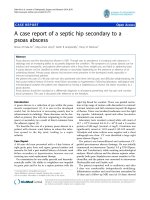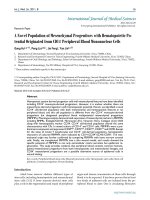Báo cáo y học: " A patient with superior semicircular canal dehiscence presenting with Tullio''''s phenomenon: a case report" pptx
Bạn đang xem bản rút gọn của tài liệu. Xem và tải ngay bản đầy đủ của tài liệu tại đây (515.05 KB, 3 trang )
BioMed Central
Page 1 of 3
(page number not for citation purposes)
Journal of Medical Case Reports
Open Access
Case report
A patient with superior semicircular canal dehiscence presenting
with Tullio's phenomenon: a case report
Richard JD Hewitt* and Anthony O Owa
Address: Department of Otolaryngology, Queen's Hospital, Rom Valley Way, Romford, Essex, RM7 0AG, UK
Email: Richard JD Hewitt* - ; Anthony O Owa -
* Corresponding author
Abstract
Introduction: Superior semicircular canal dehiscence represents a manageable cause of sound
and pressure induced vertigo. This case highlights its presentation and investigation, including a
review of the literature, and the authors' surgical technique used in its successful treatment.
Case presentation: A 45-year-old Caucasian man presented with vertigo induced by sound or
pressure. Subsequent investigation revealed dehiscence of the superior semicircular canal and the
patient underwent a surgical repair.
Conclusion: Surgery to repair or resurface the dehiscence represents an effective treatment
modality, offering a resolution of symptoms with no detrimental effect on hearing or long-term
sequelae. A five-layer composite repair consisting of temporalis fascia – bone pate – conchal
cartilage – bone pate – temporalis fascia has been found to be safe and effective.
Introduction
Dehiscence of bone overlying the superior semi-circular
canal was described in 1998 by Minor et al. [1] as a cause
of sound and pressure induced vertigo. The condition of
superior semicircular canal dehiscence has subsequently
been the topic of numerous articles exploring the clinical
presentation, investigation and management of the disor-
der. The incidence of dehiscent bone has been reported in
cadaveric analysis to lie between 0.4 and 0.5%, with thin-
ning of the bone to <0.1 mm in a further 1.4% [2].
Symptoms include one or more of the following: sound
induced vertigo, often in a vertical-torsional plane; con-
ductive hyperacusis; and chronic feelings of disequilib-
rium and motion intolerance [3]. Clinical evaluation with
a patient exposed to sound or pressure, wearing Frenzel's
glasses, reveals nystagmus of an upward and anticlockwise
nature in a right-sided lesion, and upward and clockwise
in a left-sided lesion [2]. Radiological imaging, with high
resolution computed tomograms of the temporal bones,
has a high sensitivity for the diagnosis of superior semicir-
cular canal dehiscence but needs to be correlated with
patient history, clinical examination and audiological and
vestibular assessment to achieve a high specificity.
The treatment is either conservative, with the avoidance of
causative stimuli, or surgical, if the symptoms are uncon-
trollable. Surgical repair or resurfacing of the dehiscence
area of bone is the recommended interventional
approach. There have, however, been many proposed
approaches, materials and techniques. However, it is
agreed that surgery can result in complete resolution of
symptoms in most patients [1]. The surgical technique has
been described with various resurfacing methods includ-
ing three- and five-layer techniques. This article describes
a surgical approach using a five-layer technique for the
Published: 23 January 2009
Journal of Medical Case Reports 2009, 3:22 doi:10.1186/1752-1947-3-22
Received: 7 May 2008
Accepted: 23 January 2009
This article is available from: />© 2009 Hewitt and Owa; licensee BioMed Central Ltd.
This is an Open Access article distributed under the terms of the Creative Commons Attribution License ( />),
which permits unrestricted use, distribution, and reproduction in any medium, provided the original work is properly cited.
Journal of Medical Case Reports 2009, 3:22 />Page 2 of 3
(page number not for citation purposes)
repair of the dehiscence conducted in a district general
hospital with complete resolution of symptoms and no
detrimental effects on hearing and no long-term sequelae
[4].
Case presentation
A 45-year-old Caucasian patient presented with a 5-year
isolated history of noise induced vertigo and a history of
head trauma 12 years ago. A Tullio test revealed the appro-
priate nystagmus, when presented with a noise of -100 dB
at 1000 Hz, to indicate a right-sided lesion. Pure tone
audiometry revealed a bilateral, symmetrical, sen-
sorineural hearing loss of 25 dB with a dip to 70 dB at
4000 Hz. High resolution computerised tomography
imaging demonstrated both superior semi-circular canals
to be dehiscent and no other abnormalities (Figure 1).
The patient was counselled as to the treatment options
and elected to have a surgical repair to the symptomatic
right side via a middle fossa approach.
The surgery was conducted in conjunction with the neuro-
surgeons and involved the harvesting of conchal cartilage,
temporalis fascia and bone pate. The dura was elevated
from the dehiscent semicircular canal and the dehiscent
tegmen resurfaced with a five-layer composite consisting
of temporalis fascia – bone pate – conchal cartilage – bone
pate – temporalis fascia. The procedure went without
complication.
Subsequent consultation, up to 18 post-operation,
revealed a total resolution of noise induced symptoms.
Tullio testing produced no nystagmus, pure tone audiom-
etry demonstrated no change in the hearing threshold and
computerised tomography imaging demonstrated an
intact, right-sided semi-circular canal (Figure 2).
Conclusion
The authors advocate the use of a five-layer composite
repair, consisting of temporalis fascia – bone pate – con-
chal cartilage – bone pate – temporalis fascia, via a middle
fossa approach to repair or resurface symptomatic dehis-
cent semicircular canals. This is a safe and effective
method with no side effects in the short to medium term.
Consent
Written informed consent was obtained from the patient
for publication of this case report and any accompanying
images. A copy of the written consent is available for
review by the Editor-in-Chief of this journal.
Competing interests
The authors declare that they have no competing interests.
Authors' contributions
AO and RH undertook the management, writing and
approval of the manuscript.
Acknowledgements
We would like to thank the Departments of Audiology, Radiology and Neu-
rosurgery for their support.
References
1. Minor LB, Solomon D, Zinreich JS, Zee DS: Sound – and/orpres-
sure induced vertigo due to bone dehiscence of the superior
semi-circular canal. Arch Otolaryngol Head Neck Surg 1998,
124:249-258.
Pre-operative temporal bone coronal computed tomography imagesFigure 1
Pre-operative temporal bone coronal computed
tomography images.
Postoperative temporal bone coronal computed tomography imagesFigure 2
Postoperative temporal bone coronal computed
tomography images.
Publish with BioMed Central and every
scientist can read your work free of charge
"BioMed Central will be the most significant development for
disseminating the results of biomedical research in our lifetime."
Sir Paul Nurse, Cancer Research UK
Your research papers will be:
available free of charge to the entire biomedical community
peer reviewed and published immediately upon acceptance
cited in PubMed and archived on PubMed Central
yours — you keep the copyright
Submit your manuscript here:
/>BioMedcentral
Journal of Medical Case Reports 2009, 3:22 />Page 3 of 3
(page number not for citation purposes)
2. Carey JP, Minor LB, Nager GT: Dehiscence or thinning ofthe
bone overlying the superior semicircular canal in a temporal
bone survey. Arch Otolaryngol Head Neck Surg 2000, 126:137-147.
3. Minor LB, Carey JP, Cremer PD, Lustig LR, Streubel SO, Ruckenstein
MJ: Symptoms and signs of Superior Canal Dehiscence Syn-
drome. Ann NY Acad Sci 2001, 942:259-273.
4. Banerjee A, Whyte A, Atlas MD: Superior Canal Dehis-
cence:review of a new condition. Clin Otolaryngol 2004, 30:9-15.









